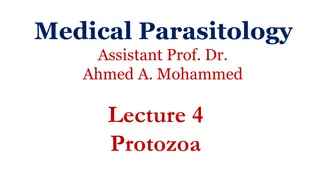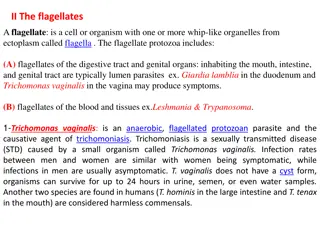Life Cycle and Morphology of Blood and Tissue Flagellates in Parasitology
Blood and tissue flagellates, such as Leishmania and Trypanosoma, have complex life cycles involving vertebrate and arthropod hosts. They go through various stages with distinct morphological features like promastigote, epimastigote, trypomastigote, and amastigote. Leishmania mainly infects mammals
0 views • 16 slides
Understanding Protozoa: The Animal-Like Unicellular Organisms
Protozoa are unicellular heterotrophic organisms that obtain nutrition by ingesting other organisms or dead organic material. They can be parasitic and are classified based on their modes of locomotion. Common groups include amoebas, flagellates, sporozoans, and ciliates. Protozoa are further catego
0 views • 16 slides
Overview of Flagellates and Their Clinical Significance
Flagellates are single-celled organisms with whip-like flagella that can cause parasitic infections in humans. Key species like Trichomonas vaginalis, Trichomonas hominis, and Giardia lamblia are discussed, highlighting their clinical implications, diagnostic methods, and treatment options.
0 views • 11 slides


